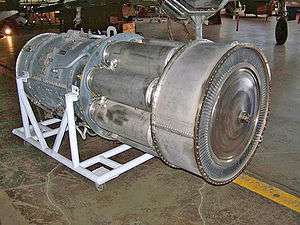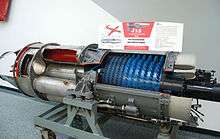Allison J35
| J35 | |
|---|---|
 | |
| The exhaust end of an Allison J35 | |
| Type | Turbojet |
| National origin | United States |
| Manufacturer | General Electric Allison Engine Company |
| First run | 1946 |
| Major applications | F-84 Thunderjet F-89 Scorpion |
| Developed into | Allison J71 General Electric J47 |
The General Electric/Allison J35 was originally developed by General Electric (GE company designation TG-180) in parallel with the Whittle-based centrifugal-flow J33, and was the United States Air Force's first axial-flow (straight-through airflow) compressor engine. The J35 was fairly simple, consisting of an eleven-stage axial-flow compressor and a single-stage turbine. With the afterburner, which most models carried, it produced a thrust of 7,400 lbf (32.92 kN).
Like the J33, the design of the J35 originated at General Electric, but major production was by the Allison Engine Company.
Design and Development
While developing the T31 axial turboprop in 1943 GE realized that they had the resources to design an axial turbojet at the same time as their centrifugal J33 engine. They recognized the axial would have more potential for the future and went ahead with the TG-180 engine.[1] GE axial compressor designs were developed from the NACA 8-stage compressor.[2]
The engine had its starter and accessories (fuel control, fuel pump, oil pumps, hydraulic pump, RPM generator)[3] mounted in the centre of the compressor inlet. This accessory layout, as used on centrifugal engines, restricted the area available for compressor inlet air. It was carried over to the J47 but revised (relocated to an external gearbox) on the J73 when a 50% increase in airflow was required.[4] It also had an inlet debris guard which was common on early jet engines.
GE developed a variable afterburner for the engine, although electronic control linked with engine controls had to wait until the J47.[5] Marrett[6] describes one of the consequences if the link is human on an afterburning engine. If the afterburner lit but the nozzle didn't open (not noticed by the pilot) the RPM governor would overfuel the engine until the turbine failed.
Operational history
The General Electric J35 first flew in the Republic XP-84 Thunderjet in 1946. Late in 1947, complete responsibility for the development and production of the engine was transferred to the Allison Division of the General Motors Corporation and some J35s were also built by GM's Chevrolet division.[7] More than 14,000 J35s had been built by the time production ended in 1955.
The J35 was used to power the Bell X-5 variable-sweep research aircraft and various prototypes such as the Douglas XB-43 Jetmaster, North American XB-45 Tornado, Convair XB-46, Boeing XB-47 Stratojet, Martin XB-48, and Northrop YB-49. It is probably best known, however, as the engine used in two of the leading fighters of the United States Air Force (USAF) in the 1950: the Republic F-84 Thunderjet and the Northrop F-89 Scorpion.
A largely redesigned development of the J35 was later produced as the Allison J71, developing 10,900 lbf (48.49 kN) thrust.
Variants
- J35-GE-2
- 3,820 lbf (16.99 kN) thrust, prototypes built by General Electric.
- J35-GE-7
- 3,745 lbf (16.66 kN) thrust, built by General Electric, powered the 2 Republic XP-84 Thunderjet prototypes
- J35-GE-15
- 4,000 lbf (17.79 kN) thrust, built by General Electric, powered the sole Republic XP-84A Thunderjet
- J35-A-3
- 4,000 lbf (17.79 kN) thrust
- J35-C-3
- 3,820 lbf (16.99 kN) thrust, production by Chevrolet.
- J35-C-3
- 4,000 lbf (17.79 kN) thrust, production by Chevrolet.
- J35-A-5
- 4,000 lbf (17.79 kN) thrust
- J35-A-9
- 4,000 lbf (17.79 kN) thrust
- J35-A-11
- 6,000 lbf (26.69 kN) thrust
- J35-A-13
- 5,200 lbf (23.13 kN) thrust
- J35-A-13C
- J35-A-15
- 4,000 lbf (17.79 kN) thrust, powered the 15 Republic YP-84 Thunderjets
- J35-A-15C
- 4,000 lbf (17.79 kN) thrust
- J35-A-17
- 4,900 lbf (21.80 kN) thrust
- J35-A-17D
- 5,000 lbf (22.24 kN) thrust
- J35-A-19
- 5,000 lbf (22.24 kN) thrust
- J35-A-21
- 5,600 lbf (24.91 kN) thrust, 7,400 lbf (32.92 kN) with afterburner
- J35-A-23
- 10,900 lbf (48.49 kN) thrust, original designation for the Allison J71
- J35-A-29
- 5,560 lbf (24.73 kN) thrust
- J35-A-35
- 7,200 lbf (32.03 kN) with afterburner
- J35-A-33
- 5,600 lbf (24.91 kN) thrust, 7,400 lbf (32.92 kN) with afterburner
- J35-A-35
- 5,440 lbf (24.20 kN) thrust, 7,200 lbf (32.03 kN) with afterburner
Applications
- Bell X-5
- Boeing XB-47 Stratojet
- Convair XB-46
- Douglas D-558-1 Skystreak
- Douglas XB-43 Jetmaster
- Martin XB-48
- North American FJ-1 Fury
- North American XB-45 Tornado
- North American XP-86 Sabre
- Northrop F-89 Scorpion
- Northrop YB-49
- Republic F-84 Thunderjet
- Vought F7U-3 Cutlass (interim test usage)
Specifications (J35-A-35)



Data from [8]
General characteristics
- Type: Afterburning turbojet
- Length: 195.5 in (4,970 mm) including afterburner
- Diameter: 43 in (1,100 mm)
- Dry weight: 2,315 lb (1,050 kg) dry, 2,930 lb (1,330 kg) including afterburner
Components
- Compressor: 11-stage axial compressor
- Combustors: Eight tubular inter-connected combustion chambers
- Turbine: Single-stage axial
- Fuel type: Aviation kerosene, JP-4, MIL-F-5624 or 100/130 octane gasoline
- Oil system: Dry sump pressure system with spur gear pressure and scavenge pumps at 35 psi (241.32 kPa)
Performance
- Maximum thrust:
- 5,600 lbf (24.91 kN) at 8,000 rpm
- 7,400 lbf (32.92 kN) with afterburner
- Overall pressure ratio: 5:1
- Air mass flow: 91 lb (41 kg) / sec at take-off power
- Specific fuel consumption: 1.1 lb/lbf/hr (112.13 kg/kN/hr)
- Thrust-to-weight ratio: 2.53 lbf/lb (0.025 kN/kg)
- Maximum operating altitude: 50,000 ft (15,000 m)
- Cost: US$ 46,000 each
See also
- Related development
- Comparable engines
- Related lists
References
- Notes
- ↑ "The Development of Jet and Turbine Engines" Bill Gunston 2006, 4th edition, Patrick Stephens, ISBN 0-7509-4477-3, p.143
- ↑ http://history.nasa.gov/SP-4306/ch3.htm
- ↑ 1956 | 0590 | Flight Archive. Flightglobal.com. Retrieved on 2013-08-16.
- ↑ https://www.flightglobal.com/pdfarchive/view/1957/1957%20-%201043.html
- ↑ "seven decades of progress" General Electric, Aero Publishers Inc. Fallbrook, ISBN 0-8168-8355-6, p.76
- ↑ "Testing Death" george j. marrett, Naval Institute Press 2006, ISBN 978-1-59114-512-7, p.21
- ↑
- ↑ Bridgman, Leonard (1955). Jane's all the World's Aircraft 1955-56. London: Jane's all the World's Aircraft Publishing Co. Ltd.
- Bibliography
- Kay, Anthony L. (2007). Turbojet History and Development 1930-1960 Volume 2:USSR, USA, Japan, France, Canada, Sweden, Switzerland, Italy and Hungary (1st ed.). Ramsbury: The Crowood Press. ISBN 978-1861269393.
External links
| Wikimedia Commons has media related to Allison J35. |
- "Foremost American Turbojet" a 1948 Flight article